The Dell Latitude 13 7390 2-in-1 Review
by Brett Howse on April 12, 2018 8:00 AM ESTDisplay
Dell’s Latitude 7390 2-in-1 has a 13-inch display, with a 1920x1080 resolution. In 2018, that might sound like a low-resolution display, but for a 13-inch business laptop, it’s arguably the right pick. Not all LOB applications work well with HiDPI displays, and the FHD resolution will help out with battery life as well.
Dell targets the sRGB gamut with this display, and while they don’t do per-device calibration like Microsoft or Apple, they do tend to offer reasonable color calibration, so we’ll see how they do with our color workflow, which uses SpectraCal CalMAN software, along with an X-Rite i1DisplayPro colorimeter for brightness and contrast readings, and the X-Rite i1Pro2 spectrophotometer for color accuracy testing.
Brightness and Contrast
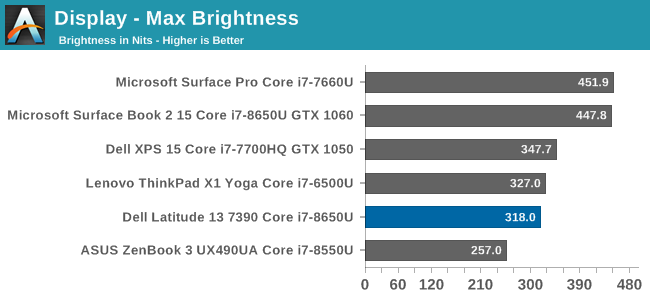
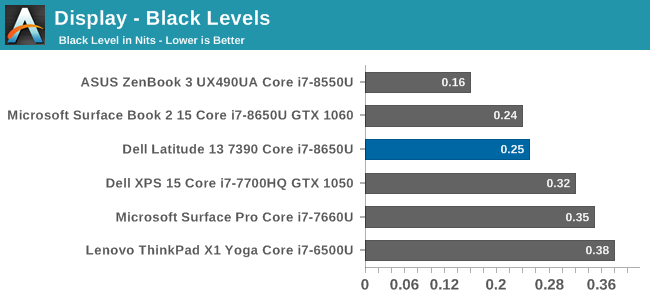
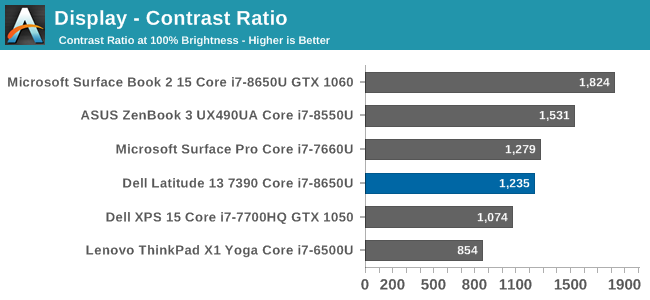
The Dell doesn’t get exceptionally bright at just about 320 nits, but it does offer good black levels, leading to a decent 1200:1 contrast ratio. If you’re going to use the Latitude outdoors, the brightness might be an issue, but for in the office, it’s plenty.
Grayscale
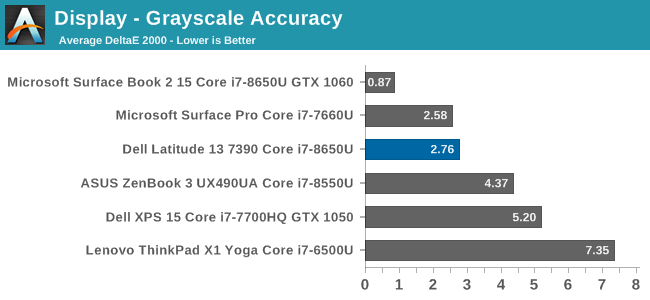
Dell does a good job with the grayscale on this laptop, which suggests they may be doing batch calibration on the panels. The overall grayscale level is quite good, at just 2.76, but also only exceeds the 3.0 level around 70% and up. 100% white is a rather high error level, due to the drop off in reds, but it’s quite a bit better than plenty of machines we’ve tested. The gamma also averages 2.3, which is pretty close to the 2.2 average, although it’s not as even as it could be. For an out-of-the box display though, this is a good result.
Gamut

At 100% on all the color levels, the Latitude once again has a good result, with a dE2000 average of just 3.3. It’s not quite as low as you’d like, but still offers good sRGB coverage.
Saturation
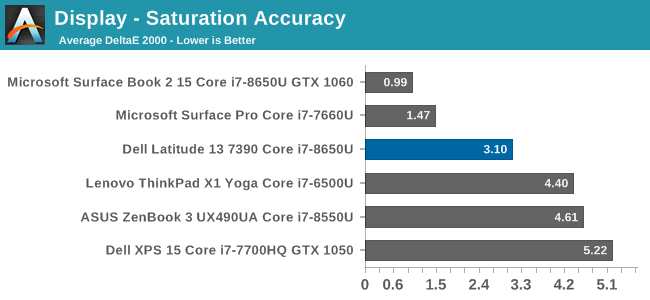
Here we can see the secondary colors fall off their axis a bit, but still offer an overall error level average that is very close to 3.0, which is quite good. Once again, not class leading, but a solid result for a device that likely doesn’t target people that are doing color critical work.
Gretag Macbeth
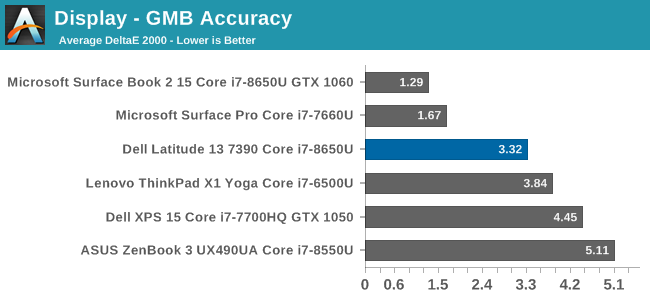
The Gretag Macbeth test is the most comprehensive, and tests the important skin tone colors. Once again, the Latitude does fairly well here, with an overall dE2000 of 3.32, but quite a few of the colors are well over the 4.0 error level.
Display Conclusion
The touch and pen ready display on the Dell Latitude 7390 doesn’t offer the highest resolution on a notebook this size, but still offers a good viewing experience, and once that would be well-suited to the target market. We’re still not at a point where anyone outside of Microsoft or Apple will individually calibrate every display, but Dell seems to be doing batch calibration of their panels, because they have good, but not amazing, calibration.














28 Comments
View All Comments
coolhardware - Sunday, April 22, 2018 - link
I still use and love the Lenovo TrackPoint (or "nub" as you refer to it). It is not trendy, but it is still very good IMHO.hybrid2d4x4 - Thursday, April 12, 2018 - link
Not trying to be facetious here: what is the use case for having a microSD reader? Many laptops are migrating to offering this where they used to offer regular SD readers, and I'm curious if this is user-driven or OEMs trying to axe a larger component?Personally, I mostly use a laptop while traveling and I use a DSLR, so I find a regular size SD reader useful. But the only device I own that uses microSD is my phone and it's more of a hassle to remove the card and use a reader than just connect the phone via USB. I wouldn't be surprised if something like GoPros used uSD, but is that demographic that large? What else is uSD broadly used for?
PeachNCream - Thursday, April 12, 2018 - link
In my own day-to-day computing, I haven't used a standard sized SD card in quite a while because the only thing I own that can accept standard sized SD cards is my laptop. It's actually a little bit annoying to go dig an adapter out of a desk drawer so I'd rather see laptops fall in line with the other consumer electronics that already have made the transition to microSD. At this point, standard SD seems a bit outdated to me.piroroadkill - Friday, April 13, 2018 - link
This is a redundant comment, because a lot of microSD cards come with a microSD to full size SD adapter. You can just leave the adapter in the slot if it bothers you that much. Other people might actually want the full size slot for their camera SD card.PeachNCream - Friday, April 13, 2018 - link
"...if it bothers you that much."It doesn't bother me that much. That's why I said it was "a little bit annoying" rather than "it bothers me a lot" or "very annoying." It just ends up seeming like you're inflating my concern in order to invalidate my comment about my own usage (which I clearly defined right away as applying to no one else but me) in order to support an opposed viewpoint.
It's fine if you want a full size SD slot. Then again, what's stopping someone from arguing that you can leave the adapter in a camera instead of a laptop? MicroSD write speed is pretty high and competitive with standard sized cards. I used an adapter in the last camera I owned a few years ago because microSD was cheaper for the same capacity and speed when I was buying storage for it.
BurntMyBacon - Friday, April 13, 2018 - link
In my day to day use, I've only really seen heavy use of microSD in phones/tablets. I have to echo the earlier sentiment that it is usually easier to just connect the phone/tablet than to remove the microSD card. A great many cameras, however, use SD. I'm sure there are plenty of devices that make use of microSD, but outside of phones/tablets, I just don't run across them. Also, it is very easy to adapt microSD to SD, but not the other way around. Furthermore, as piroroadkill pointed out, it wouldn't be at all problematic to leave the microSD to SD card adapter in the SD slot if you wanted a more permanent microSD solution.sofie123 - Friday, April 13, 2018 - link
As i have seen the features and the specification of the Dell Latitude 7392 it is quite a great gadget to be owned. The Dell Alienware is also great gadget if you are a game freak.https://www.uaetechnician.com/alienware-support-se...
RErro - Thursday, April 26, 2018 - link
Finally, a review on a business laptop.